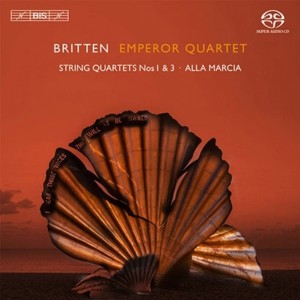 Benjamin Britten (1913-1976) is de meest succesvolle Engelse componist van de 20ste eeuw. Hij schreef drie strijkkwartetten waarvan no. 1 en 3, aangevuld met ‘Alla Marcia‘ uit 1933, worden uitgevoerd door het Engelse Emperor Quartet. Britten verwerkt op geraffineerde wijze de modernismen in zijn composities waardoor zijn muziek velen aanspreekt.
Benjamin Britten (1913-1976) is de meest succesvolle Engelse componist van de 20ste eeuw. Hij schreef drie strijkkwartetten waarvan no. 1 en 3, aangevuld met ‘Alla Marcia‘ uit 1933, worden uitgevoerd door het Engelse Emperor Quartet. Britten verwerkt op geraffineerde wijze de modernismen in zijn composities waardoor zijn muziek velen aanspreekt.
English version below
Benjamin Britten schreef als kind van negen zijn eerste composities die hij later gebruikt voor zijn debuut Simple Symphony Op. 4. Hij toont al gauw de kunst van het weglaten: met weinig middelen, muzikaal het meest vertellen. Hij wordt vooral bekend door ‘A Ceremony of Carols’, de opera ‘Peter Grimes’ en natuurlijk ‘The Young Person’s Guide to the Orchestra’ uit 1945. Een werk waarin alle secties van het symfonie orkest aan bod komen met variaties over een thema van Henry Purcell. Een Engelse Barok componist waar Britten grote bewondering voor had en aan wie hij zijn 2de strijkkwartet opdraagt: niet op deze cd.
Wel op deze cd staat het bijzondere strijkkwartet no. 1 dat opent met hoog gestreken violen, ondersteund met pizzicato (tokkelen) op de cello. Dit in tegenstelling tot het begin van het tweede deel waar juist de verschillende partijen markant over elkaar heen duiken. De muziek van Britten is zeer melodisch. Soms met heel korte thema’s of motiefjes maar steeds affectief, dat tot uiting komt in de bewerkingen waar forte en pianissimo (hard en zacht) elkaar minutieus kunnen afwisselen. Dat vergt ’n eenduidige muzikale benadering waarbij belangrijke en minder belangrijke partijen duidelijk hoorbaar moeten zijn. Het Emperor Quartet speelt in één kleur, dat fantastisch hoorbaar is in het derde strijkkwartet (met vijf delen) waar thema’s klinken in een nuance, waar atonaliteit soms even om hoek gluurt en de verschillende strijkers moeiteloos schakelen tussen begeleiding of solo fragmenten. In het laatste deel horen we bovendien een subtiele verwijzing naar Henry Purcell die ferm wordt neergezet. Het Emperor Quartet plaatst met deze cd het werk van Britten weer in de tegenwoordige tijd, precies waar het thuishoort!
English version
Benjamin Britten (1913-1976) is the most successful English composer of the 20th century. He wrote three string quartets which no. 1 and 3 you’ll find on this cd, played by the English Emperor Quartet and added with ‘Alla Marcia‘ from 1933. Britten used modernism in his compositions which might be the secret his success.
Britten wrote in his childhood (9 years) his first compositions which he used later in the debut Simple Symphony Op. 4. He shows the art of dropping parts: tell the whole musical story with less kind of instrumentation. He got famous by his compositions ‘A Ceremony of Carols’, the opera ‘Peter Grimes’ and of course ‘The Young Person’s Guide to the Orchestra’ from 1945. A work in which he shows the whole orchestra by a variations on a theme, written by the English composer Henry Purcell, who Britten admired and to which he dedicated in his string quartet no. 2 (not on this cd).
This lovely cd opens with the string quartet no.1. The first part starts with high bow played violins, accompanied by pizzicato on the cello. In the second part you hear the opposite: differtent parts, short themes played after another. Britten’s music is very melodic and affective. The main purpose of a string quartet is to play with the same musical approach. The Emperor Quartet plays with óne color. Lovely is string quartet no. 3 (with five parts) where theme’s are played very accurate, where atonal music sometimes shows up and the different strings easily switch between accompany and solo parts. In the last piece you hear a subtle link to Henry Purcell. The Emperor Quartet put Britten’s music to the present and that is just where it belongs!
- Emperor Quartet: Stringquartets Nos 1 & 3 – Alla Marcia Britten (BIS/New Arts International)
© Mattie Poels.

Geen reacties